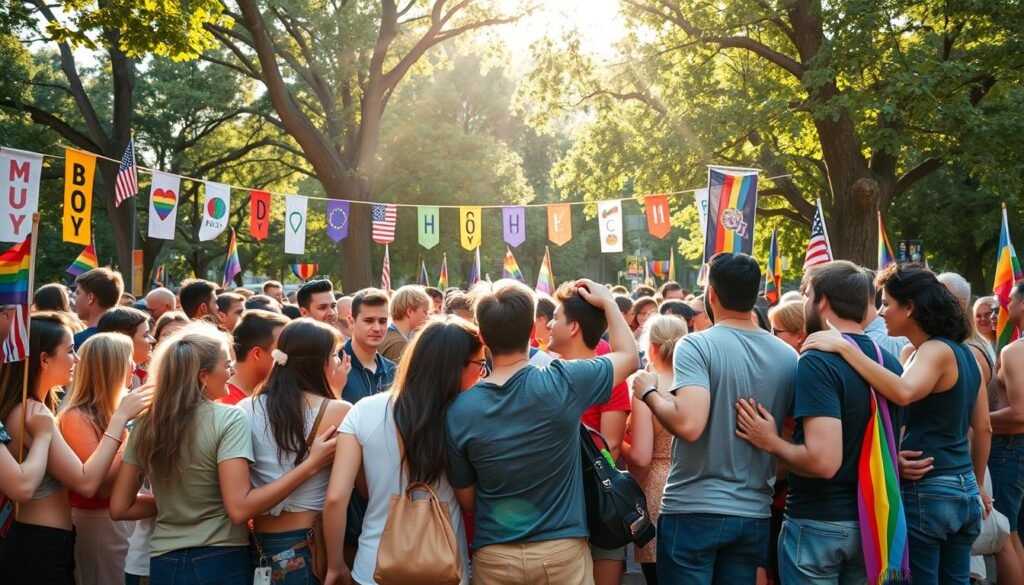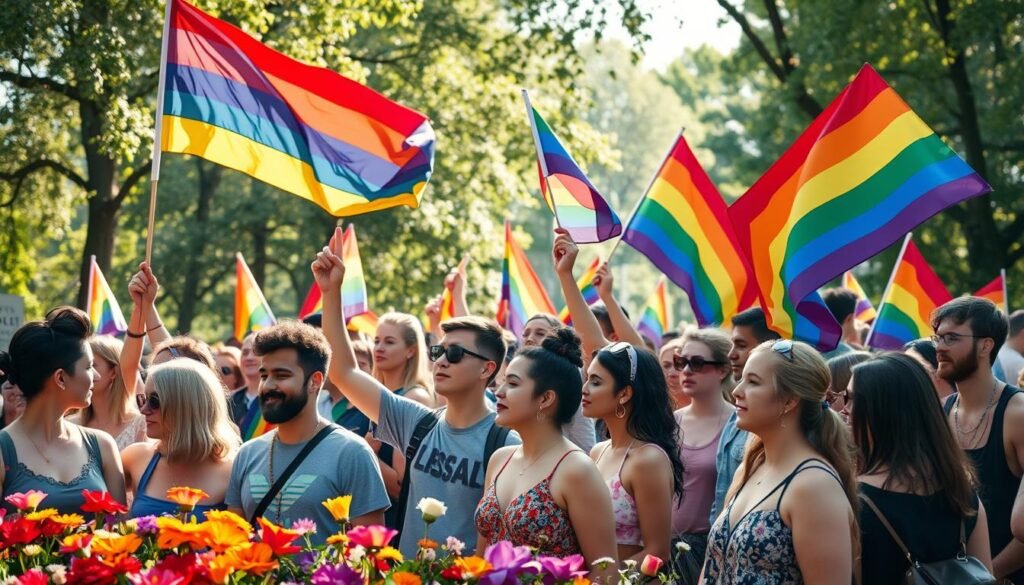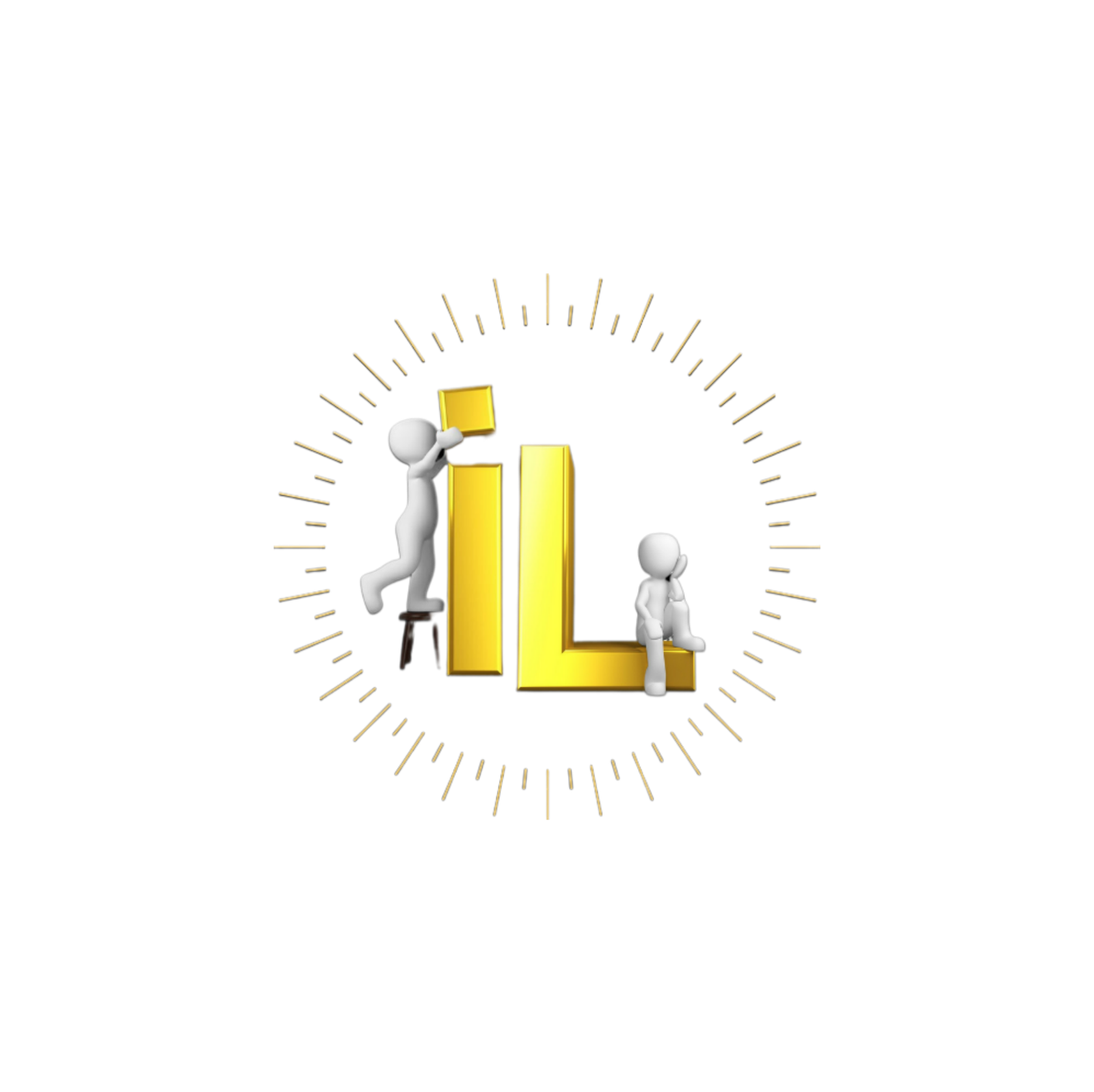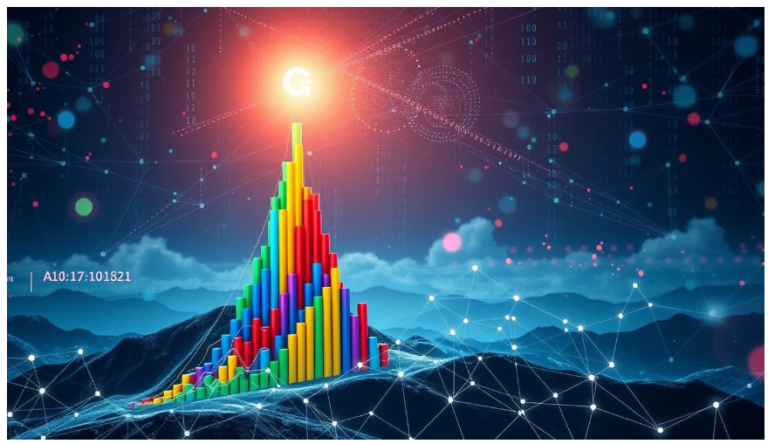What does it mean to be homosexual today? How can we understand and accept sexual orientation and same-sex relationships? The topic of homosexuality is growing, with many supporting LGBTQ+ individuals and promoting inclusivity. It’s key to consider the diversity of human experiences and the need for empathy and respect for everyone, no matter their sexual orientation.
The book “The Complete Christian Guide to Understanding Homosexuality” by Joe Dallas offers valuable insights. It covers topics like the origins of homosexuality, counseling advice, and policy concerns like same-sex marriage. With endorsements from pastors and Christian leaders, this book provides a compassionate view on same-sex attraction. It also offers practical resources for those interested in the subject. As we explore homosexuality, understanding sexual orientation and its impact on same-sex relationships is crucial.

Key Takeaways
- Homosexuality is a complex and multifaceted topic that requires understanding and acceptance.
- Sexual orientation is an enduring pattern of emotional, romantic, and/or sexual attractions to men, women, or both sexes.
- LGBTQ+ individuals face unique challenges and require support and inclusivity.
- The book “The Complete Christian Guide to Understanding Homosexuality” provides valuable insights and resources for individuals interested in the subject.
- Promoting empathy and respect for all individuals, regardless of their sexual orientation, is essential for creating a more inclusive society.
- Same-sex relationships are an important aspect of the LGBTQ+ community and require understanding and support.
Understanding Sexual Orientation and Homosexuality
Sexual orientation is a complex part of who we are. It’s different from our biological sex, gender identity, and social roles. The American Psychological Association says it’s a spectrum, from attraction to the opposite sex to the same sex.
This spectrum includes many categories. These are heterosexual, homosexual or gay/lesbian, bisexual, and asexual. There are also pansexual and polysexual orientations, though less known.
The LGBTQ community is diverse, with many sexual orientations and gender identities. Finding out one’s sexual orientation is a personal journey. It can be shaped by genetics, hormones, and our environment.
It’s important to know that questioning one’s sexual orientation is normal. The American Psychological Association says it’s not a mental illness. They also stress the need for LGBTQ rights and support for the LGBTQ community.
Studies show that our sexual orientation starts to form between 6 and 13 years old. The reasons for this are still not fully understood. But, it’s clear that gay marriage and relationship recognition are key for LGBTQ+ individuals.
By understanding and accepting everyone, we can build a more inclusive society. This acceptance is crucial for the well-being and equality of all, no matter their sexual orientation or gender identity.
The Historical Evolution of LGBTQ+ Recognition
The journey of recognizing LGBTQ+ individuals has seen big changes over time. In the 20th century, the push for gay and lesbian rights started to grow. This was thanks to feminism and studies on differences. It was a key moment in the fight for LGBTQ+ rights, as coming out and showing same-sex attraction became more common.
Historians say that every culture has shown signs of homosexual activity. The term “LGBTQ” has changed to include more people, like those who are lesbian, gay, bisexual, transgender, queer, intersex, and asexual. The acronym now stands for unity and solidarity, especially during pride month. This month celebrates the diversity and individuality of the LGBTQ+ community.
- The first recorded depiction of homosexual partners, dating back to around 9600 BCE in Sicily, Italy
- Evidence of homosexuality in cave artwork in Zimbabwe, extending as far back as 8000 BCE
- The introduction of anti-LGBTQ legislation in the Middle Assyrian Empire in 1075 BCE
These events show the long and complex history of LGBTQ+ recognition. They highlight the struggles and victories of those who have fought for their rights and identities.
Today, the LGBTQ+ community keeps growing and changing. There’s a big push for inclusivity and acceptance. As we move forward, it’s important to remember the historical value of coming out and showing same-sex attraction. Also, we must celebrate pride month for its role in bringing unity and solidarity to the LGBTQ+ community.
The Science Behind Sexual Orientation
Research on sexual orientation has made big strides, revealing how biology, psychology, and society shape it. The lgbt community has led this effort, fighting for gay rights and raising awareness about sexual identity and gender expression.
Scientists still debate why people are attracted to others in different ways. But most agree that biology, including genes and hormones, plays a big part. For example, research shows that hormones before birth are key in shaping sexual orientation.
A study with nearly half a million participants found that genes account for only 8 to 25 percent of same-sex attraction. It also found that many genes, each making a small contribution, influence sexuality. This makes sexual orientation a complex trait.
Understanding the science behind sexual orientation is crucial. It affects the lgbt community and their quest for gay rights. By embracing and accepting sexual identity and gender expression, we can build a more welcoming world for everyone, no matter their sexual orientation.
| Study | Sample Size | Findings |
|---|---|---|
| Genetic Heritability Study | 500,000 | Genetic heritability explains 8-25% of same-sex relations |
| Prenatal Hormones Study | 1,000 | Prenatal hormones play a crucial role in sexual orientation development |
Coming Out: Personal Journey and Social Impact
The journey of coming out is key for the lgbtq+ community. It’s about finding oneself and can be tough. Pride and diversity are vital in this process. They help bring acceptance and inclusivity.
Many LGBT people share their identity with friends. In fact, 86% do. This shows how important having supportive friends is. Most LGBT adults figure out their identity by age 19.
Coming out affects not just the person but also their community and society. It’s crucial to support sexual diversity. This way, everyone can be themselves without fear. The lgbtq+ community is rich and varied, with many identities.
Some important facts about coming out are:
- 96% of gay men and 94% of lesbians have told at least one close friend about their sexual orientation.
- 77% of gay men and 71% of lesbians say all or most important people know about their sexual orientation.
- 64% of LGBT adults with a college degree say that all or most important people in their lives know about their sexual orientation or gender identity.
In summary, coming out is a personal journey that needs support and acceptance. By celebrating pride, diversity, and sexual diversity, we make a welcoming space. This benefits the lgbtq+ community and society.

Same-Sex Relationships in Modern Society
Same-sex relationships are now widely recognized and accepted. The queer community has made big strides. Many countries have legalized same-sex marriage and passed anti-discrimination laws.
A recent survey found that 62% of Americans support gay and lesbian marriage. Also, 69% believe homosexuality should be accepted by society.
The lgbt community has seen more acceptance, especially among the young. 83% of 18 to 29-year-olds support accepting homosexuality. This change comes from better education and seeing more lgbt people in media and public life.
Building support networks is key for the queer community. It gives them a sense of belonging and acceptance. This can happen through online forums, support groups, and community events.
By promoting acceptance and inclusivity, we can make a welcoming space for everyone. This is true, no matter their sexual orientation.
| Country | Acceptance of Homosexuality |
|---|---|
| Sweden | 94% |
| Netherlands | 92% |
| Germany | 87% |
The queer community has made great progress. It’s vital to keep promoting acceptance and inclusivity. This will help create a welcoming space for everyone.
Legal Rights and Recognition Worldwide
The fight for lgbt rights has been long and hard. In recent years, we’ve seen big steps forward. Yet, in 64 countries, being gay is still against the law. Many of these laws were made by European colonizers.
But, there are also places moving forward. 37 countries now allow same-sex marriage. This includes the United States, Canada, and the UK. This change is thanks to the hard work of lgbtq activists.
Some important moments in the fight for lgbt rights include:
- Legalization of same-sex marriage in countries like Greece, Estonia, and Liechtenstein
- Recognition of non-binary gender in some places
- Anti-discrimination laws to protect lgbt individuals
There’s still a lot to do, but we’ve made great progress. This shows the strength of lgbtq activism. As we keep fighting for equality, we must remember the importance of lgbt rights.
The Role of Pride and LGBTQ+ Community
The LGBTQ+ community has been key in fighting for lgbt rights and acceptance. Pride events, held in June, are a big part of this fight. These events include parades, marches, and festivals, drawing millions of people.
Pride events started after the 1969 Stonewall riots, a major moment in the gay and lesbian rights movement. Today, Pride is celebrated worldwide, giving the community a chance to unite and fight for their rights.
Some notable Pride events include the Christopher Street Liberation Day, marking the 1969 New York City events. The National Coming Out Day Celebration in October is another important event. These events are crucial for promoting lgbt rights and acceptance.
The LGBTQ+ community has also made progress through education and advocacy. Groups like the Lavender Council and the Pride Faculty and Staff Association support the community. Their work has helped create a more inclusive world for the gay and lesbian community, paving the way for future activism.
Addressing Discrimination and Promoting Acceptance
The lgbtq+ community faces many challenges, including discrimination and prejudice. These issues can harm their mental health and well-being. Education and awareness are key to promoting acceptance and reducing discrimination.
By learning about the queer community and their experiences, we can create a more inclusive place. This helps everyone feel welcome and valued.
Workplace inclusion is also vital. Many lgbt individuals face discrimination at work, leading to social isolation and mental health issues. Employers can make a difference by supporting diversity and inclusion.
Creating a safe and supportive work environment is crucial. It helps all employees, regardless of their sexual orientation or gender identity, feel valued and respected.
Healthcare access is another important area. The lgbt community often faces barriers in getting healthcare, which can worsen health conditions. Providing inclusive healthcare services is essential for their well-being.

To fight discrimination and promote acceptance, we must value social acceptance and inclusivity. Working together, we can make a welcoming environment for the lgbtq+ community and queer individuals. This promotes their well-being and health.
| Category | Percentage |
|---|---|
| LGBTQ+ individuals who have experienced discrimination | 40% |
| LGBTQ+ individuals who have experienced violence | 20% |
| LGBTQ+ individuals who have experienced social isolation | 30% |
Conclusion: Embracing Diversity and Moving Forward
As we wrap up this guide on homosexuality, it’s key to see how far LGBTQ+ rights have come. The LGBTQIA+ acronym shows we’re getting better at understanding the variety of sexual orientations and gender identities. But, we still have a long way to go to achieve true equality and inclusion.
Big wins like the legalization of same-sex marriage in the U.S. are important steps. Yet, the LGBTQ+ community still faces many challenges. They deal with discrimination, from workplace harassment to healthcare gaps and social prejudice.
To move forward, we must listen more to LGBTQ+ voices and experiences. We need to build a culture that values understanding and acceptance. By improving education, workplace policies, and healthcare, we can create a society that celebrates diversity.
Let’s celebrate the strength and pride of the LGBTQ+ community. We must keep working towards a world where everyone can be themselves without fear. Together, we can overcome barriers, challenge stereotypes, and build a future filled with acceptance and respect for all.
FAQ
What is homosexuality?
Homosexuality is when someone is attracted to the same gender. It’s a natural part of human diversity.
How is sexual orientation defined?
Sexual orientation is a range of attractions, from straight to gay and everything in between. It’s a key part of who we are.
What is the history of the LGBTQ+ movement?
The LGBTQ+ movement has a rich history. It’s filled with important moments and people who fought for acceptance.
What are the scientific perspectives on sexual orientation?
Scientists think sexual orientation comes from biology, psychology, and society. They’re still learning about this complex part of us.
What is the personal journey of coming out?
Coming out is a personal journey. It’s about sharing who you are with others. It can be emotional but is important for acceptance.
How are same-sex relationships recognized in modern society?
Same-sex relationships are a big part of today’s society. They have their own challenges and joys, like any relationship.
What are the legal rights and recognition of LGBTQ+ individuals worldwide?
Laws for LGBTQ+ people vary worldwide. There’s progress, like marriage rights, but there’s still a lot of work to do.
What is the significance of Pride and the LGBTQ+ community?
Pride is important for acceptance and equality. It’s a time for celebration and fighting for rights.
How can discrimination be addressed and acceptance be promoted?
To fight discrimination, we need education and awareness. We also need to make places welcoming for everyone.
In my personal opinion: I am against this immoral society that seeks to change the sound human nature, and I am not convinced by their stupid ideas. This article is only for you to know about them and protect your family and those close to you from their evil world.
Source Links
- https://www.harvesthousepublishers.com/books/complete-christian-guide-to-understanding-homosexuality-9780736925075?srsltid=AfmBOooQoGHGsn1iy_n3JHRyBTl2JodfAqFu8N_9z-IunMZMz2PAScOO
- https://www.fundamentallyreformed.com/2011/03/01/the-complete-christian-guide-to-understanding-homosexuality-edited-by-joe-dallas-and-nancy-heche/
- https://www.ebay.com/itm/126742271047
- https://www.thoughtco.com/what-is-sexual-orientation-4169553
- https://www.mentalhealth.com/library/homosexuality-and-bisexuality
- https://www.apa.org/topics/lgbtq/history
- https://www.nationalgeographic.com/history/article/from-lgbt-to-lgbtqia-the-evolving-recognition-of-identity
- https://www.publiclyprivate.org/culture/lgbtq-history
- https://www.apa.org/topics/lgbtq/orientation
- https://www.pbs.org/newshour/science/there-is-no-gay-gene-there-is-no-straight-gene-sexuality-is-just-complex-study-confirms
- https://en.wikipedia.org/wiki/Biology_and_sexual_orientation
- https://www.pewresearch.org/social-trends/2013/06/13/chapter-3-the-coming-out-experience/
- https://saccenter.org/coming-out-lgbtq-transgender/
- https://www.pewresearch.org/politics/2017/10/05/5-homosexuality-gender-and-religion/
- https://www.pewresearch.org/global/2020/06/25/global-divide-on-homosexuality-persists/
- https://www.amnesty.org/en/what-we-do/discrimination/lgbti-rights/
- https://www.hrc.org/resources/marriage-equality-around-the-world
- https://www.equaldex.com/
Click here to learn more about this topic in a related article.




